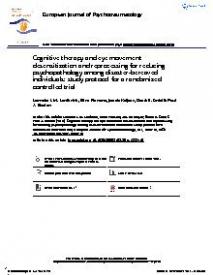Cognitive therapy and eye movement desensitization and reprocessing for reducing psychopathology among disaster-bereaved individuals : study protocol for a randomized controlled trial
Background: Confrontation with a traumatic (e.g. disaster-related) loss is a risk factor for the
development of psychopathology, including symptoms of prolonged grief (PG), posttraumatic
stress (PTS), and depression. Although interventions have been developed for reducing
post-loss psychopathology, more research into the effectiveness of treatment is needed
to improve care for bereaved persons. Cognitive therapy (CT) and eye movement desensitization
and reprocessing (EMDR) have been shown to be effective in trauma-exposed
populations. We hypothesize that CT and EMDR are also effective in reducing symptoms
among people exposed to traumatic loss.
Objective: In this article we describe the rationale of a randomized controlled trial (RCT) to
examine (1) treatment effects of CT and EMDR for reducing PG, PTS, and depression among
traumatically bereaved people, and (2) the associations between improvements in PG, PTS, and
depression symptoms on the one hand and tentativemechanisms of change, including a sense of
unrealness, negative cognitions, avoidance behaviour, and intrusive memories, on the other hand.
Method: A two-armed (intervention versus waiting list controls) RCT will be conducted.
Participants will be asked to fill in questionnaires prior to treatment, during treatment, and
one, 12, and 24 weeks post-treatment. Potential participants are people who have lost one
or multiple significant other(s) in the Ukrainian plane disaster in 2014 with clinically
significant levels of self-rated PG, PTS, and/or depression. Multiple regression, including
analysis of covariance, and multilevel regression analyses will be used.
Discussion: There is a need for treatment for psychopathology following traumatic loss.
Strengths of this study are the development of a treatment that targets grief and traumarelated
complaints and the examination of potential mechanisms of change in CT and EMDR.
Bereaved people, clinicians, and researchers could benefit from the results of this study.
In: European journal of psychotraumatology, ISSN 2000-8066 | 8 | 1388710
https://doi.org/10.1080/20008198.2017.1388710


